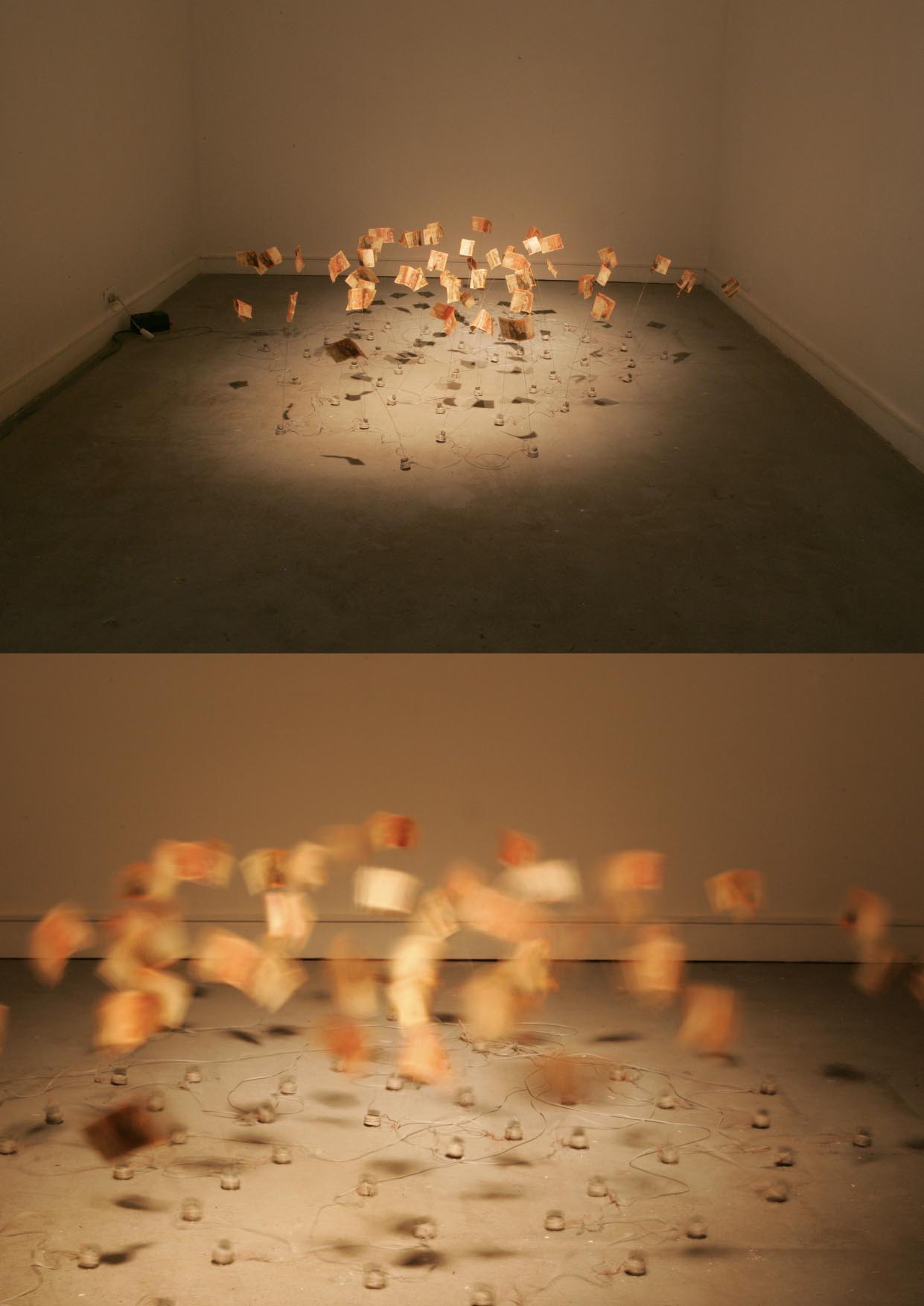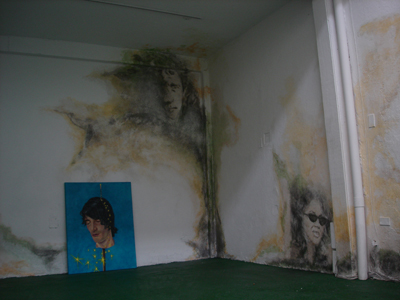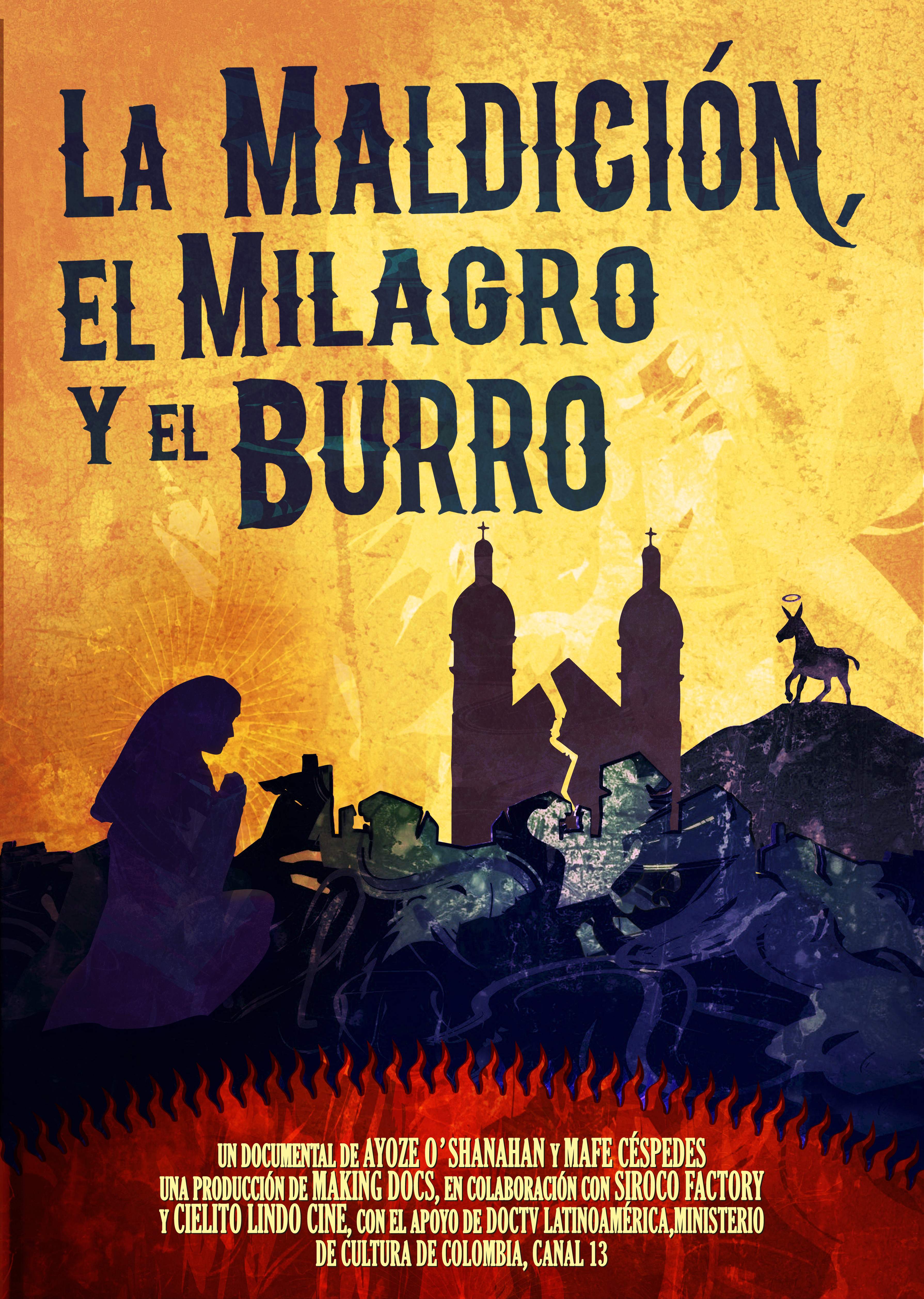LAZNIA 1 2014 - BOGOTA. A CITY ON THE EDGE
23 November 2013 – 19 January 2014
Opening: 22 November 2013, 6 pm
Artists: Jaime Ávila, Alberto Lezaca de Paz, Andrés R. Londoño, Adriana Salazar
Curators: Sylwia Krasoń, John Angel Rodriguez
CSW Łaźnia, ul. Jaskółcza 1, Gdańsk Dolne Miasto
The Visions of Colombia. The screening of documentaries.
23-24 November 2013
Curator: Madeleine Navarro Mena
Kinoport, ul. Strajku Dokerów 5, Gdańsk Nowy Port
The project is funded in part by the Ministry of Culture and National Heritage.
The exhibition presents Bogota city through the artists’ eyes, which gaze focuses on their experience living and working in the capital of the country. Bogota has emerged in the last decade as a one of the megacities in Latin America with the highest development and growth index, characterized by a multicultural complexity coexisting with enormous problems of social gaps and security. The history of the country, as well as the social and family lives have implicit the long period of violence, the drug mafia presence, and the corrupted political ambiance, that still remain as unsolved problems. The contrast is marked by the cultural ambiance that have made of Bogota that `paradise for the intellectual spirit`, with freedom of speech and multiple origin voices. The exhibition is an attempt to understand how this melting pot produces this disseminated and boiling artistic dynamics. The gathered artwork reveals the social and urban power of the city: daily life, channels of communications and rhythm of the urban common-life. Artists raise questions about how the city dwellers cope with errors and imperfections of a system. The system in where an urban development is a fiction and where the structure of power is unpredictable and beyond imagination.
To define and describe ambiguity, contradiction and paradoxes of Bogota, artists develop a critical approach full of bittersweet laughter. Sad smile/smile through tears unmasks issues such as disorder, consumerism, poverty, injustice, violence, corruption and displacement. Dark humor contented in artwork seems to be a survival strategy to mirrors social disruptions. Another method to scrutinize the reality is an escape into own imagination. The creation of parallel reality, unearth the picture of dirty sides of Bogota Street.
How it is to be a contemporary artist in Bogota?....
Bogota. A City on the Edge is part of the Cities on the edge project in which we present art from areas that are “on the edge” – beyond the limits of our interest, associated with conflicts rather than with art.
The displayed kinetic installation Fifty Thousand by Adriana Salazar is composed of fifty 1000 Colombian peso banknotes. Each of the notes is attached to an oblong spring, which is connected to a simple engine. When a viewer approaches the work, the movement is sensed by a detector, which activates the whole mechanism. A sudden rush of rustling banknotes breaks the silence. The bills, fluttering in a quick, rhythmical pattern, resemble a flock of birds about to raise from the ground. The artist is interested in matters which oscillate around the representation of behaviours and gestures typical of humans and live organisms and performed without their participation. To this end, Salazar observes our everyday actions – those performed automatically, which we do not think about – pointless, but repetitive. Her works are an attempt of sorts at drawing our attention to the absurdities of our everyday life.

Adriana Salazar, Fifty Thousand, kinetic installation, 1000 Colombian peso banknotes, springs, sensor and electric engines, 2010
The multimedia installation Estados de simulación / A State of Simulation by Alberto Lezaca de Paz is going to be reconstructed in situ during the artist’s residence in Gdańsk. The work is composed of plywood, a cube and a video projection. Using simple construction materials and a computer-generated image, the artist is going to create a magic-filled environment in Łaźnia. Shades and colourful geometrical pictures are going to appear at the joint of walls, while the cube with a pile of wooden boards will be transformed into an illuminated, oneiric architectural form. In his works, Lezaca often refers to the modernisation of urban infrastructure in Bogota. The city undergoes constant renovation, but the omnipotent corruption in state bodies effectively hampers the completion of urban development projects. In consequence, the urban landscape is a mixture of several styles, which gives an absurd final effect.

Alberto Lezaca de Paz, Estados de simulacion / State of Simulation, site-specific installation, wood, Plexiglas and video, 2011
Especially for the Łaźnia CCA, Jaime Ávila has prepared a series of drawings entitled Paisajes de polvo / Dust Landscapes. They depict a bird’s-eye view of nocturnal landscapes. Lines, subtly marked with ink and accentuated with spots of light, meander in high mountain ranges. The artist only seemingly invites us to admire a night-time panorama of the enchanting Andes. The romantic nocturne is in fact a view of motorways illegally constructed by drug peddlers in explosive, dangerous zones, completely separated from the rest of the world.

Jaime Ávila, Paisajes de Polvo / Dust Landscapes, drawings, ink on Plexiglas, 2013
During his residence in Gdańsk, Andrés R. Londoño is going to create a wall painting entitled Mould. This work has been presented e.g. in Bogota. At that occasion, Londoño made a portrait of some of the most influential representatives of the local art world. However, it was not a tribute paid to Colombian curators, collectors and celebrities. The figures emerged from a yellowed, brownish undercoat, which resembled mould. They were painted next to the ceiling, in the corners and at the floor level. The entire work evoked a damp basement, infested with wet rot.
The mural will be supplemented by an interactive project entitled Kunstomerservice. During his stay in Gdańsk, Londoño will invite the viewers to a dialogue on the consumerist approach to art. Londoño’s project will introduce us to the mechanisms of the functioning of the Bogota art scene.

Andrés Londoño, Mould, acrylic painting on wall installation 2013
BIOGRAPHICAL NOTES
Adriana Salazar (born 1980) – interdisciplinary artist, who works with installation, sculpture and painting. In her art, she focuses on recognising the limits between the natural and the artificial. Based on her observations, she creates kinetic art objects, which perform various impractical, sometimes absurd actions: a cigarette-smoking machine, a machine which tries to thread a needle, a crying machine. Her works are based on simple designs and executed manually, while their movements may seem clumsy.
Adriana Salazar has graduated in Fine Arts at the Jorge Tadeo Lozano University in Bogota and in Philosophy at the Javeriana University in Bogota. Her works have been shown at international exhibitions, festivals and art biennales in Europe, Asia, North and South America. She is a holder of a scholarship of the Akiyoshidai International Art Village in Japan and the Nordic Artists’ Centre in Norway. She lives and works in Bogota.
Alberto Lezaca de Paz creates contextual installations in which he uses construction materials and video projections, drawing on the aesthetics of applied design. His latest works focus on utopian visions of 1930s modernist architecture and their links to the current state of urban landscape.
In recent years, Alberto Lezaca de Paz has participated in collective exhibitions such as Enfrentamiento, Laboratorio de Arte Espacio-G, Valparaiso, Chile (2011), Muestra de Vídeo Enfrentamiento, Ateliê 397, São Paulo, Brasil (2011), Gran Enciclopedia Acémila, Galería Facultad de Artes ASAB, Bogota, Colombia (2011). He has recently participated in a residency programme at the Gaswork gallery in London (2012). He lives and works in Bogota.
Jaime Ávila (born 1967) combines painting, photography and drawing in his art. For Ávila, his art is a pretext to draw attention to social and economic problems affecting Latin American countries. For example, in his project 4th World – Five Cubic Meters, he demonstrated the destructive force of poverty along with the chaotic urban building development of seven Latin American cities.
Jaime Ávila Ferrera represented Colombia at international festivals and exhibitions, e.g. in Brazil, England and the United States (e.g. The Boston Arts Academy). Avila is one of the most influential artists of his generation. He lives and works in Bogota.
Andrés R. Londoño – a painter and draughtsman – combines various styles in his works, creating painterly contextual installations. He experiments with various techniques and materials. In his works, he takes a critical view of the art circles both in Colombia and Europe.
Andrés R. Londoño obtained his B.A at the Jorge Tadeo Lozano University in Bogota. He is currently finishing his M.A. studies in Art in the Urban Space at the Bauhaus University in Weimar. He has numerous exhibitions under his belt, e.g. at the Alliance Française, Colombo American Centre and Pereira Art Museu. Londoño currently lives and works in Weimar and Berlin.
The artists invited to take part in the exhibition have developed subtle alphabet to talk about social aspects of being inhabitant of Bogota. The Vision of Colombia offers a different view on this urban narration. The films presented within the screening interrogate social issues such as drug mafia, violence, paramilitary organizations, it shows the country through the eye of the artist, Beatriz González. The screening will create an interesting background, it will provide the Polish audience with the opportunity to understand the strategy of the young generation of Colombian artists.
The complex socio-political panorama of Colombia during the last six decades has been continuously reflected in the cinema of this country, particularly in its documentaries. This short screening neither pretends nor can possibly encompass all the aspects of such complicated reality. However, this selection focuses on the particular vision of the directors on the re-current themes that Colombia invokes in the public conscience: the violence of armed conflict, its aftermath and drug trafficking. But more than anything, the documentaries in this selection depict an almost magical capacity of the reinvention and survival of Colombian people, so often mentioned and celebrated in the work of their most renowned writer – Gabriel García Márquez.
23-24 November 2013
The Visions of Colombia. The screening of documentaries.
Curator: Madeleine Navarro Mena
Kinoport, ul. Strajku Dokerów 5, Gdańsk Nowy Port
Programme:
23. 11. 2013,
• 05.00 p.m
Beatriz González, Why Are You Crying? I’ve already laughed Monologue in Three Voices (Beatriz González ¿Por qué lloras si ya reí? Monólogo a tres voces)
Director: Diego García Moreno
Country: Colombia
Release date: 2010
Running time: 80 min.
The screening will be preceded by curator’s talk, meeting with the artists taking part in the exhibition and exhibition curators
The work of painter Beatriz González follows the history of Colombia, step by step, during half a century. Initially full of humor and irony, her work has in time adopted the tragic tone that currently characterizes her country. This documentary in the form of a monologue weaves together the life of a great thinker, a witty and critical body of work, and the somber future of a nation grown accustomed to violence and death.
Diego García Moreno was born in Medellin, Colombia. He is a director and a producer of films and documentaries. Graduated from the L'École nationale supérieure Louis-Lumière in Paris, France. Upon his return to Colombia in 1984 he directed the following documentaries: “La balada del mar no visto” (1984), “Manrique mi viejo barrio” (1985) y “El Oro de María del Pardo” (1986). In late 1989 he went back to France to work as a producer and director of various documentaries. From 1992 to 1995 he directed the documentary triology “Colombia elemental: El trompo, La arepa y La corbata”. After a definite and final return to his home country, he directs and produces “Colombia Horizontal: la cama, la hamaca, la estera, la acera y el ataúd” (1998), : “La canoa de la vida (2000), “Colombia con-sentido (2000), “Las castañuelas de Notre Dame” (2001), “El corazón” (2006), “Y como para qué arte de qué” (2008), “¡Danza, Colombia! ” (2008). Currently García Moreno is the director of Lamaraca Producciones, with which in 2010 he produced his documentary “Beatriz González. Por qué llora si ya reí. Monologo a tres voces”. He was a co-founder of the Association of the Producers of Documentaries - ALADOS.

Beatriz González, Why Are You Crying? I’ve already laughed Monologue in Three Voices - movie poster, courtesy the artist
• 08.15 p.m
The Curse, the Miracle and the Donkey (La maldición, el milagro y el burro)
Director: María Fernanda Céspedes, Ayoze O'shanahan
Country: Colombia
Release date: 2012
Running time: 52 min.
This is the story of a small community in the region of North of Santander (Colombia) which throught its people, political and religious figures will testify about the past, present and future a community that saw their houses fall one by one, slowly, to the rhythm of nature. In this community the harsh winter rains that has no precedent, added to the misuse of natural resources and poor urban planning, led to the displacement of the earth, a geological phenomenon in particular, leaving the 150th anniversary of a town, converted into weed.
María Fernanda Céspedes Ruíz: A film and TV producer born in Colombia. Graduated from the Faculty of Advertising from the University of Jorge Tadeo Lozano and specialized in audiovisual production in la Escuela de San Antonio de los Baños in Cuba and in creative documentary cinema in la Universidad del Valle of Colombia. Co-founder of Cielitolindo Cine, Colombian production company of cinema and TV. “La Maldición, el milagro y el burro” is her first documentary.
Ayoze O’Shanahan Correas: He holds a bachelor’s degree in Journalism from the University of Wales (United Kingdom), and is a Specialist in Armed Conflicts and News Media from the Complutense University of Madrid. In 2002, he studied Production and Script Writiing at the San Antonio de los Baños Film School (Cuba). In 2006, he created the production company Siroco Factory in order to independently produce documentary and film projects. He has produced and directed his last four documentaries: “The Adventure of Tobacco” (2005), “Death has no friends” (2006), “Case 11.227 Colombia” (2009), “The Curse, the Miracle and the Donkey” (2012).

The Curse, the Miracle and the Donkey - movie poster, courtesy the artist
24.11.2013
• 5.00 p.m
La Sierra (La Sierra)
Director: Scott Dalton, Margarita Martínez
Country: Colombia
Release date: 2005
Running time: 84 min.
A searing portrayal of three young lives defined by violence, the award-winning documentary. LA SIERRA traces a year in the life of a small Colombian neighbourhood ruled by paramilitary thugs. The film is an intimate, meditative exploration, revealing not only startling moments of violence and its aftermath, but also the tenderness and faith that enable this community to survive.
Scott Dalton: Is an award-winning photographer and filmmaker based in Houston Texas. He has spent years working throughout Latin America, including extensive coverage of Colombia, where he lived for over ten years photographing the civil conflict and drug war. His photography has appeared in The New York Times, Harper´s, Time, Newsweek, National Geographic, Der Spiegel, Washington Post Magazine among other outlets. His documentary film “La Sierra” (co-directed wiht Margarita Martínez), won numerous awards and has been broadcast by PBS, BBC, HBO Latino, and many other international broadcasters.
Margarita Martínez is a Colombian documentary filmmaker and journalist. She began her career at NBC News in New York. Later she covered the Colombian conflict for seven years for the Associated Press in Bogotá. Her first film (co-directed with Scott Dalton), “La Sierra” -the most viewed documentary on Colombian television in the country's history- received several international awards. Martínez has made two full-length films “Robatierra” and “La Ola Verde,” called Antanas' Way in English and the short documentaries “La batalla del silencio” for the Interamerican Press Association, “Justicia en la tierra de los muertos,” broadcast by the BBC in 2010 and “Marimbas y Cantadoras,” about the festival of Music from the Pacific Coast Petronio Álvarez. She is now finishing up a film about education and inequality in Colombia for Caracol TV. Martínez received her law degree from the Universidad de los Andes in Bogotá and her Master's in journalism and international relations from Columbia University in New York. She was a 2009 Nieman Fellow at Harvard University.

La Sierra - movie poster, courtesy the artist
The white money. Coca a bit more than just a drug (La plata blanca. Cuando la coca es algo más que una droga)
Director: José Luis Sánchez Hachero
Country: Spain, Colombia
Release date: 2009
Running time: 52 min.
After screening the meeting with the director of the documentary José Luis Sánchez Hachero will take place
Inside the jungles of Colombia, farmers develop their life around coca. The grown, processed coca paste use as currency in trade. The shopkeeper gets grams in exchange for corn or beer, the priest accepts alms in grams and prostitutes dust powder change. The narcotics police sprayed tons of herbicide on the region but grows coca plantings while legal crops perish burned. Fumigation leave also displaced thousands of farmers in all directions and new coca leaf surfaces deeper in the jungle. This is the story of an economic system based on the gram of cocaine, narrated and sung by the protagonists.
José Luis Sánchez Hachero, Huelva, Spain, 1970. Live and work in Cádiz, SpainTV reporter, Filmmaker. Photojournalist. Colaborator and Corresponsal to differents mass media between 1997-2013: Tiempo (Spain), Ya (Spain), Interviu (Spain). Since 1998 TV reporter in Cadiz and Gibraltar Strait. Specialist in war conflicts: East Timor, Kashmir, Kosovo, Croatia, Lebanon, Colombia, and humanitarian conflicts: Haiti, Senegal, Nagorno-Karabagh, Myanma. From 2005 to 2010 Documentary Filmmaker of Yagé Producciones, Spain/ Colombia.

La Plata Blanca - movie still, courtesy the artist
The films are in Spanish with the Polish subtitles






 BIP
BIP